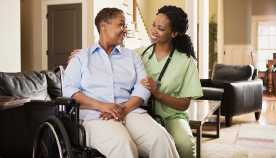Activity And Sleep Trackers Show Promise For Improving Overall Health Of Older Consumers Despite Some Usability Challenges
New Study Reveals Opportunities to Improve the Use and Long-Term Adoption of Trackers Meaningful Behavior Change Observed in Almost Half of Participants
WASHINGTON, DC—AARP today released the results of a study of popular activity and sleep tracker usage by the 50-plus population, showing that – while consumers are excited about new technology and the potential benefits of sleep and activity trackers – the devices’ design and utility are lacking in features that would encourage long-term use or adoption. The gap between expectations and reality indicates a significant opportunity to better serve the 50-plus market.
Georgia Tech Research Institute’s HomeLab in partnership with the recently launched Project Catalyst: The Power of We initiative, a program that encourages tech developers to design toward the 50-plus demographics’ desire for longevity and wellness, gave 92 older consumers one of seven popular devices to use at home for six weeks in their daily lives. At the end of the six-week trial:
- 71 percent of participants reported increased awareness of activity, sleep or eating habits;
- 45 percent reported increased motivation;
- 46 percent said they changed their behavior; and
- 67 percent of participants reported the activity and sleep tracker to be beneficial or of value.
“Despite what some people may think, the study showed that consumers in the 50-plus age group enjoy interacting with technology when it provides them with constructive and usable feedback on their goals,” said Dr. Brad Fain, a director of Georgia Tech’s HomeLab and principal research scientist at the Georgia Tech Research Institute (GTRI). “They are motivated to use new products that help them achieve good health and avoid illness – important findings as we seek to improve technology and make life easier for this underserved population.”
The study, “Building a Better Tracker: Older Consumers Weigh in On Activity and Sleep Monitoring Devices” is the first of several health technology studies under the Project Catalyst initiative that AARP will conduct and report on as part of its effort to accelerate innovation for aging Americans. With the support of MedStar Health, Pfizer Inc. and UnitedHealthcare, this initiative seeks to identify ways to improve products and services for the 50-plus population -- who are the largest consumers of healthcare.
With regard to how future activity and sleep trackers can be improved for consumers in the 50-plus age range, the study confirmed that the success of the next generation of trackers is directly correlated to their ease of use and their effectiveness. The results align with the mission of AARP – to identify challenges and determine solutions to improve the quality of life for people as they age.
Study Recommendations for Improvement
“The recommendations that came out of the study are to make trackers better able to share information on health goals important to 50-plus consumers, simplify set up, make them unobtrusive to wear and easier to maintain, and provide more features like timely alerts and instantaneous access to information,” said Jody Holtzman, AARP Senior Vice President of Thought Leadership. “If these qualities are prioritized, the potential in the 50-plus market for activity and sleep trackers is likely to grow.”
Other specific recommendations from the study’s participants included:
- Providing detailed, easy-to-understand instructions
- Providing an explanation of how activity and sleep trackers collect data
- Ensuring robust syncing capabilities
- Ensuring comfort while wearing the tracker
- Enabling timely notifications targeted to 50-plus consumers
- Providing a display for instant information access
- Incorporating additional sensors related to health-specific conditions
Project Catalyst is the latest in a series of efforts led by AARP to encourage the development of products that can improve the quality of life for Americans as they age by raising awareness of the economic power of consumers who are 50-plus and conducting research about their wants and needs regarding innovative products. This influential demographic is comprised of over 100 million people responsible for at least $7.1 trillion in annual economic activity – a figure that is expected to reach well over $13.5 trillion in real terms by 2032, according to Oxford Economics.
The next Project Catalyst study is already underway at the Georgia Tech’s HomeLab and looks at medication management tools designed to help people take their medicine on time and as prescribed.
For a complete copy of the sleep and activity trackers study please visit:http://www.aarp.org/content/dam/aarp/home-and-family/personal-technology/2015-07/innovation-50-project-catalyst-tracker-study-AARP.pdf
For more information about Project Catalyst please visit www.aarp.org/projectcatalyst
# # #
About AARP AARP is a nonprofit, nonpartisan organization, with a membership of nearly 38 million, that helps people turn their goals and dreams into real possibilities, strengthens communities and fights for the issues that matter most to families such as healthcare, employment and income security, retirement planning, affordable utilities and protection from financial abuse. We advocate for individuals in the marketplace by selecting products and services of high quality and value to carry the AARP name as well as help our members obtain discounts on a wide range of products, travel, and services. A trusted source for lifestyle tips, news and educational information, AARP produces AARP The Magazine, the world's largest circulation magazine; AARP Bulletin; AARP Online ; AARP TV & Radio; AARP Books; and AARP en Español, a Spanish-language website addressing the interests and needs of Hispanics. AARP does not endorse candidates for public office or make contributions to political campaigns or candidates. The AARP Foundation is an affiliated charity that provides security, protection, and empowerment to older persons in need with support from thousands of volunteers, donors, and sponsors. AARP has staffed offices in all 50 states, the District of Columbia, Puerto Rico, and the U.S. Virgin Islands. Learn more at AARP Online.
CONTACTS:
Monique O’Grady, 202.434.2563, media@aarp.org
Hilary Lefebvre, 212.300.4929, Hilary@AcadiaCo.com























































